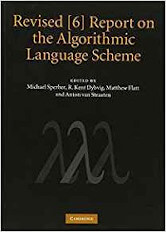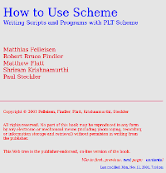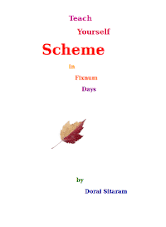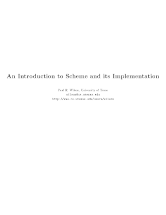Last Updated on May 18, 2025
4. Revised Report on the Algorithmic Language Scheme by Richard K Elsey, William Clinger, Jonathan Rees
 Revised Report on the Algorithmic Language Scheme gives a defining description of the programming language Scheme.
Revised Report on the Algorithmic Language Scheme gives a defining description of the programming language Scheme.
This report is accompanied by a report describing standard libraries; references to this document are identified by designations such as “library section” or “library chapter”. It is also accompanied by a report containing non-normative appendices.
A fourth report gives some historical background and rationales for many aspects of the language and its libraries.
Chapters cover:
- Introduction – provides a brief history of Scheme and the report, with an overview of Scheme’s semantics.
- Lexical conventions – an informal account of some of the lexical conventions used in writing Scheme programs looking at identifiers, whitespace and comments, and other notations.
- Basic concepts – variables, syntactic keywords, and regions, external representations, storage model, and proper tail recursion.
- Expressions – describes the syntax and semantics of primitive and derived expressions.
- Program Structure – describes the syntax and semantics of programs and definitions.
- Standard Procedures – describes Scheme’s built-in procedures, including all of Scheme’s data manipulation and input/output primitives.
- Formal Syntax and Semantics – provides a formal syntax for Scheme written in extended BNF, along with a formal denotational semantics. An example of the use of the language follows the formal syntax and semantics.
5. How to Use Scheme: The Book by Matthias Felleisen, Robert Bruce Findler, Matthew Flatt, Shriram Krishnamurthi, Paul Steckler
 How to Use Scheme bridges the gap between the basic steps of how to design programs and how to design large programs that interact with all kinds of items in our computer and the network to which it is connected. It introduces the reader to some pretty basic ideas, such as file input and output, to more advanced things, such simple GUI design and Web scripting.
How to Use Scheme bridges the gap between the basic steps of how to design programs and how to design large programs that interact with all kinds of items in our computer and the network to which it is connected. It introduces the reader to some pretty basic ideas, such as file input and output, to more advanced things, such simple GUI design and Web scripting.
Chapters cover:
- File Input and Output:
- S-expressions.
- XML and X-expressions.
- The Conventional Way.
- Reading and Writing Binary Data.
- Ports:
- Ports.
- Files and Ports.
- Strings and Ports.
- Networking and Ports.
- Creating Your Own Ports.
- Strings and Regular Expressions.
- Scheme Programs and Shell Scripts.
- Files and Directories.
- CGI Scripts.
- Threads and Custodians.
- Modules and Collections.
- Classes and Interfaces.
- The Graphics Toolbox.
- COM Scripting and Dynamic HTML.
The Web tree is the publisher-endorsed, on-line version of the book.
6. Teach Yourself Scheme in Fixnum Days by Dorai Sitaram
 Teach Yourself Scheme in Fixnum Days is an introductory book on the Scheme programming language using the Racket Scheme implementation.
Teach Yourself Scheme in Fixnum Days is an introductory book on the Scheme programming language using the Racket Scheme implementation.
It is intended as a quick-start guide, something a novice can use to get a non-trivial working knowledge of the language, before moving on to more comprehensive and in-depth texts.
Chapters explore:
- Enter Scheme.
- Data types – simple and compound data types, other data types, and S-expressions.
- Forms – procedures, apply, and sequencing.
- Conditionals – when and unless, cond, case, and and or.
- Lexical Variables – let and let, fluit-let.
- Recursion – letrec, Named let, Iteration, and mapping a procedure across a list.
- I/O – input/output (I/O) procedures that will let you read from an input port or write to an output port.
- Macros – a macro is defined using the special form define‑macro.
- Structures – default initializations, defstruct defined.
- Alists and tables – alist is a Scheme list of a special format.
- System interface – checking for and deleting files, calling operating-system commands, environment variables.
- Objects and classes – a simple object system, classes are instances too, multiple inheritance.
- Jumps – Scheme allows program control to jump to arbitrary locations in the program, in contrast to the more restrained forms of program control flow allowed by conditionals and procedure calls. This chapter shows how the call-with-current-continuation operator can be used to create a breathtaking variety of control idioms.
- Nondeterminism – description of amb, implementing amb in Scheme, using amb in Scheme, and logic puzzles.
- Engines – represents computation that is subject to timed preemption.
- Shell scripts – Hello, World!, again, Scripts with arguments.
- CGI scripts – scripts that reside on a web server and can be run by a client (browser).
7. An Introduction to Scheme and its Implementation by Paul R Wilson
 This book is for people who are interested in how Scheme works, or people who are interested in Scheme in terms of programming language design – as well as people who are just interested in using Scheme.
This book is for people who are interested in how Scheme works, or people who are interested in Scheme in terms of programming language design – as well as people who are just interested in using Scheme.
It also provides an introduction to Scheme for programmers – it is not for first time programmers but for people who already know how to program (at least a little) and are interested in learning Scheme.
Pages in this article:
Page 1 – The Scheme Programming Language and more books
Page 2 – Revised Report on the Algorithmic Language Scheme and more books
All books in this series:
| Free Programming Books | |
|---|---|
| Ada | ALGOL-like programming language, extended from Pascal and other languages |
| Agda | Dependently typed functional language based on intuitionistic Type Theory |
| Arduino | Inexpensive, flexible, open source microcontroller platform |
| Assembly | As close to writing machine code without writing in pure hexadecimal |
| Awk | Versatile language designed for pattern scanning and processing language |
| Bash | Shell and command language; popular both as a shell and a scripting language |
| BASIC | Beginner’s All-purpose Symbolic Instruction Code |
| C | General-purpose, procedural, portable, high-level language |
| C++ | General-purpose, portable, free-form, multi-paradigm language |
| C# | Combines the power and flexibility of C++ with the simplicity of Visual Basic |
| Clojure | Dialect of the Lisp programming language |
| ClojureScript | Compiler for Clojure that targets JavaScript |
| COBOL | Common Business-Oriented Language |
| CoffeeScript | Transcompiles into JavaScript inspired by Ruby, Python and Haskell |
| Coq | Dependently typed language similar to Agda, Idris, F* and others |
| Crystal | General-purpose, concurrent, multi-paradigm, object-oriented language |
| CSS | CSS (Cascading Style Sheets) specifies a web page’s appearance |
| D | General-purpose systems programming language with a C-like syntax |
| Dart | Client-optimized language for fast apps on multiple platforms |
| Dylan | Multi-paradigm language supporting functional and object-oriented coding |
| ECMAScript | Best known as the language embedded in web browsers |
| Eiffel | Object-oriented language designed by Bertrand Meyer |
| Elixir | Relatively new functional language running on the Erlang virtual machine |
| Erlang | General-purpose, concurrent, declarative, functional language |
| F# | Uses functional, imperative, and object-oriented programming methods |
| Factor | Dynamic stack-based programming language |
| Forth | Imperative stack-based programming language |
| Fortran | The first high-level language, using the first compiler |
| Go | Compiled, statically typed programming language |
| Groovy | Powerful, optionally typed and dynamic language |
| Haskell | Standardized, general-purpose, polymorphically, statically typed language |
| HTML | HyperText Markup Language |
| Icon | Wide variety of features for processing and presenting symbolic data |
| J | Array programming language based primarily on APL |
| Java | General-purpose, concurrent, class-based, object-oriented, high-level language |
| JavaScript | Interpreted, prototype-based, scripting language |
| Julia | High-level, high-performance language for technical computing |
| Kotlin | More modern version of Java |
| LabVIEW | Designed to enable domain experts to build power systems quickly |
| LaTeX | Professional document preparation system and document markup language |
| Lisp | Unique features - excellent to study programming constructs |
| Logo | Dialect of Lisp that features interactivity, modularity, extensibility |
| Lua | Designed as an embeddable scripting language |
| Markdown | Plain text formatting syntax designed to be easy-to-read and easy-to-write |
| Objective-C | Object-oriented language that adds Smalltalk-style messaging to C |
| OCaml | The main implementation of the Caml language |
| Pascal | Imperative and procedural language designed in the late 1960s |
| Perl | High-level, general-purpose, interpreted, scripting, dynamic language |
| PHP | PHP has been at the helm of the web for many years |
| PostScript | Interpreted, stack-based and Turing complete language |
| Prolog | A general purpose, declarative, logic programming language |
| PureScript | Small strongly, statically typed language compiling to JavaScript |
| Python | General-purpose, structured, powerful language |
| QML | Hierarchical declarative language for user interface layout - JSON-like syntax |
| R | De facto standard among statisticians and data analysts |
| Racket | General-purpose, object-oriented, multi-paradigm, functional language |
| Raku | Member of the Perl family of programming languages |
| Ruby | General purpose, scripting, structured, flexible, fully object-oriented language |
| Rust | Ideal for systems, embedded, and other performance critical code |
| Scala | Modern, object-functional, multi-paradigm, Java-based language |
| Scheme | A general-purpose, functional language descended from Lisp and Algol |
| Scratch | Visual programming language designed for 8-16 year-old children |
| SQL | Access and manipulate data held in a relational database management system |
| Standard ML | General-purpose functional language characterized as "Lisp with types" |
| Swift | Powerful and intuitive general-purpose programming language |
| Tcl | Dynamic language based on concepts of Lisp, C, and Unix shells |
| TeX | Markup and programming language - create professional quality typeset text |
| TypeScript | Strict syntactical superset of JavaScript adding optional static typing |
| Vala | Object-oriented language, syntactically similar to C# |
| VHDL | Hardware description language used in electronic design automation |
| VimL | Powerful scripting language of the Vim editor |
| XML | Rules for defining semantic tags describing structure ad meaning |
